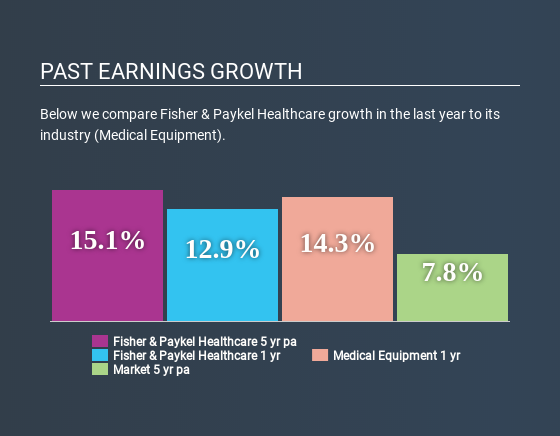Fisher & Paykel Healthcare Corporation Limited's (NZSE:FPH) Stock Is Going Strong: Is the Market Following Fundamentals?

Most readers would already be aware that Fisher & Paykel Healthcare's (NZSE:FPH) stock increased significantly by 33% over the past three months. Given the company's impressive performance, we decided to study its financial indicators more closely as a company's financial health over the long-term usually dictates market outcomes. In this article, we decided to focus on Fisher & Paykel Healthcare's ROE.
Return on equity or ROE is an important factor to be considered by a shareholder because it tells them how effectively their capital is being reinvested. In simpler terms, it measures the profitability of a company in relation to shareholder's equity.
Check out our latest analysis for Fisher & Paykel Healthcare
How Do You Calculate Return On Equity?
Return on equity can be calculated by using the formula:
Return on Equity = Net Profit (from continuing operations) ÷ Shareholders' Equity
So, based on the above formula, the ROE for Fisher & Paykel Healthcare is:
25% = NZ$233m ÷ NZ$919m (Based on the trailing twelve months to September 2019).
The 'return' is the income the business earned over the last year. So, this means that for every NZ$1 of its shareholder's investments, the company generates a profit of NZ$0.25.
What Is The Relationship Between ROE And Earnings Growth?
Thus far, we have learnt that ROE measures how efficiently a company is generating its profits. Depending on how much of these profits the company reinvests or "retains", and how effectively it does so, we are then able to assess a company’s earnings growth potential. Assuming all else is equal, companies that have both a higher return on equity and higher profit retention are usually the ones that have a higher growth rate when compared to companies that don't have the same features.
A Side By Side comparison of Fisher & Paykel Healthcare's Earnings Growth And 25% ROE
To begin with, Fisher & Paykel Healthcare has a pretty high ROE which is interesting. Additionally, the company's ROE is higher compared to the industry average of 11% which is quite remarkable. This likely paved the way for the modest 15% net income growth seen by Fisher & Paykel Healthcare over the past five years. growth
We then compared Fisher & Paykel Healthcare's net income growth with the industry and we're pleased to see that the company's growth figure is higher when compared with the industry which has a growth rate of 12% in the same period.
The basis for attaching value to a company is, to a great extent, tied to its earnings growth. It’s important for an investor to know whether the market has priced in the company's expected earnings growth (or decline). Doing so will help them establish if the stock's future looks promising or ominous. One good indicator of expected earnings growth is the P/E ratio which determines the price the market is willing to pay for a stock based on its earnings prospects. So, you may want to check if Fisher & Paykel Healthcare is trading on a high P/E or a low P/E, relative to its industry.
Is Fisher & Paykel Healthcare Making Efficient Use Of Its Profits?
The high three-year median payout ratio of 65% (or a retention ratio of 35%) for Fisher & Paykel Healthcare suggests that the company's growth wasn't really hampered despite it returning most of its income to its shareholders.
Moreover, Fisher & Paykel Healthcare is determined to keep sharing its profits with shareholders which we infer from its long history of paying a dividend for at least ten years. Based on the latest analysts' estimates, we found that the company's future payout ratio over the next three years is expected to hold steady at 66%. However, Fisher & Paykel Healthcare's ROE is predicted to rise to 33% despite there being no anticipated change in its payout ratio.
Summary
Overall, we are quite pleased with Fisher & Paykel Healthcare's performance. We are particularly impressed by the considerable earnings growth posted by the company, which was likely backed by its high ROE. While the company is paying out most of its earnings as dividends, it has been able to grow its earnings in spite of it, so that's probably a good sign. The latest industry analyst forecasts show that the company is expected to maintain its current growth rate. To know more about the company's future earnings growth forecasts take a look at this free report on analyst forecasts for the company to find out more.
If you spot an error that warrants correction, please contact the editor at editorial-team@simplywallst.com. This article by Simply Wall St is general in nature. It does not constitute a recommendation to buy or sell any stock, and does not take account of your objectives, or your financial situation. Simply Wall St has no position in the stocks mentioned.
We aim to bring you long-term focused research analysis driven by fundamental data. Note that our analysis may not factor in the latest price-sensitive company announcements or qualitative material. Thank you for reading.

